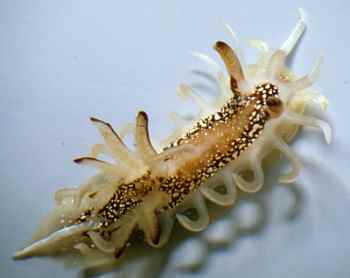
Okenia barnardi
Baba, 1937
Order: NUDIBRANCHIA
Suborder: DORIDINA
Superfamily: ANADORIDOIDEA
Family: Goniodorididae
DISTRIBUTION
Originally described from Japan is known from only a few records from Japan and Hong Kong.
PHOTO
Hong Kong. Site 11.87, South Ninepin (SE), 19 m. Depth range: 4-19 m. AM C149770, 4 specimens, 16 March 1986. Photo: B.W. Darvell
The body is elongately ovate, relatively high and lacks a distinct mantle edge although its position is clearly marked by the 8 or 9 large lateral papillae along each side, all of similar size. Usually the 2 most posterior papillae on each side are arranged one above the other on a common base. There is also a single mediodorsal papilla, similar in shape and length to the lateral papilla, just in front of the gills. The gills are long and simple and arranged in 3 clusters. The rhinophores are long, similar in length to the dorsal papillae. It grows to 10 mm long.
The body is translucent white. The dorsum is dark brown, with opaque white spots of irregular size and shape, except for area in the midline between the gills and the rhinophores. which is a much lighter translucent brown, and has fewer and smaller opaque white spots. The posterodorsal part of the foot has a brownish tinge and there is a broad opaque white median line which runs to the posterior tip of the foot. The rest of the foot is translucent white with scattered opaque white spots. The mantle papillae are translucent whitish and the upper half of the anterior 4 are opaque white. In the other papillae the white cap is replaced by an opaque white line which runs up the outer edge. The posterior side of the rhinophore stalk is dark brown with white spots, and the rest of the rhinophore is translucent brown except for the tip which is also dark brown. The gills are translucent brown with a dark brown line along the outer edge.
Okenia barnardi is known from very few records from Japan and China. It has similarities in external shape and anatomy to Okenia virginiae and O. mellita. Externally this species can be characterized by its colour pattern, the relatively numerous recurved lateral papillae, and the single medio-dorsal papilla. See message #12642 for photos of radula. We have little information on the natural history of this species, but Bernard Picton's observations [message #5962] suggests it feeds on an encrusting bryozoan.
-
Rudman, W.B. & Darvell, B.W. (1990) Opisthobranch molluscs of Hong Kong. Part 1. Goniodorididae, Onchidorididae, Triophidae, Gymnodorididae, Chromodorididae, (Nudibranchia). Asian Marine Biology, 7: 31-79
-
Rudman, W.B. (2004) Further species of the opisthobranch genus Okenia (Nudibranchia: Goniodorididae) from the Indo-West Pacific. Zootaxa, 695: 1-70.
Rudman, W.B., 2004 (December 21) Okenia barnardi Baba, 1937. [In] Sea Slug Forum. Australian Museum, Sydney. Available from http://www.seaslugforum.net/factsheet/okenbarn
Related messages
-
Okenia cf. barnardi from Ratnagiri, India.
From: Vishal Bhave, January 20, 2010 -
Okenia barnardi laying eggs in Korea
From: Dong Bum Koh, February 4, 2005 -
Radula of Okenia barnardi
From: Bill Rudman, December 21, 2004 -
Okenia barnardi from Japan
From: Yukari Sato, November 25, 2003 -
Okenia barnardi from Hong Kong
From: Bill Rudman & Brian Darvell, January 12, 2002 -
Okenia barnardi from Hong Kong
From: Bernard Picton , January 12, 2002 -
Food of Okenia barnardi in Hong Kong
From: Bernard Picton , January 12, 2002
